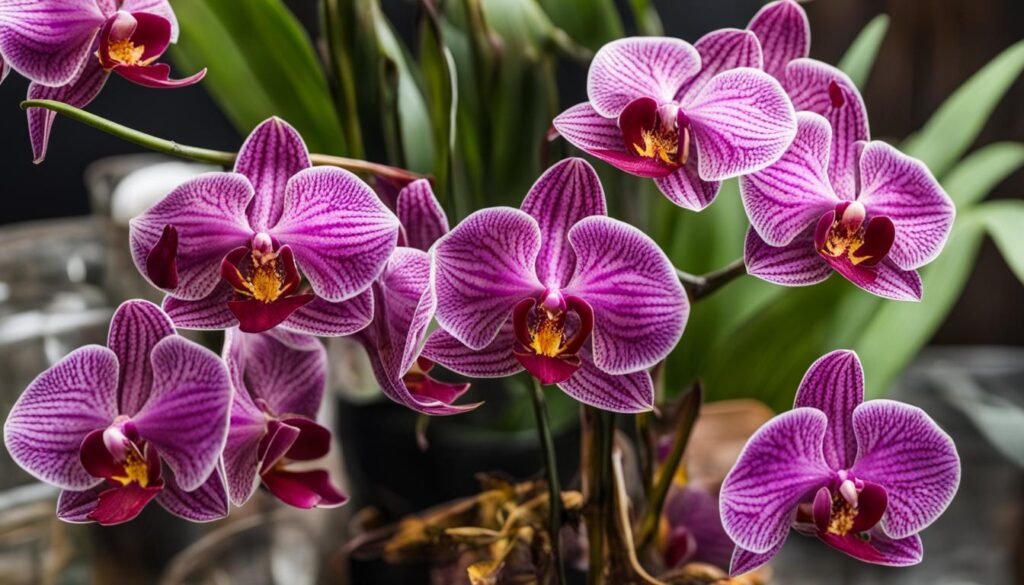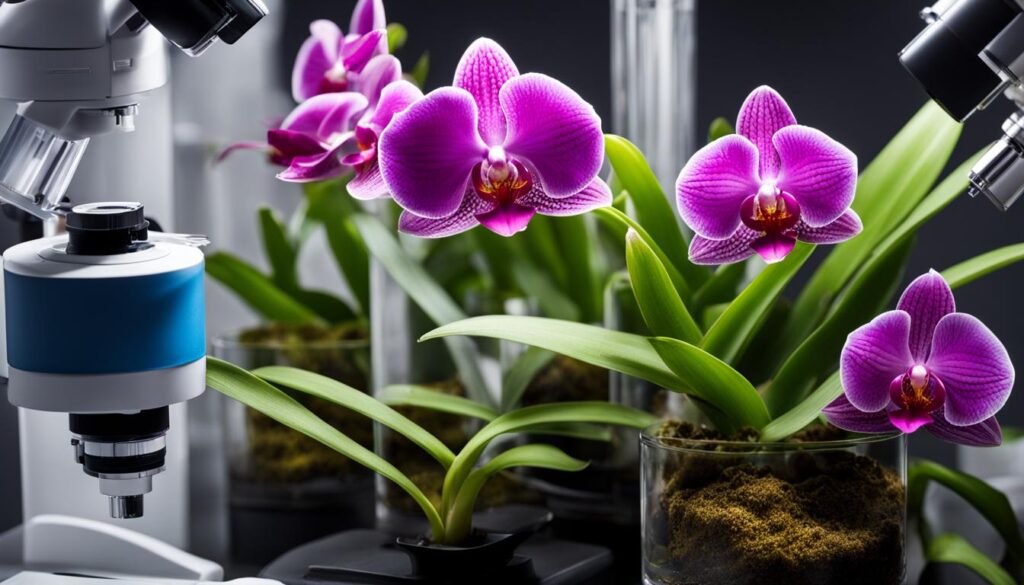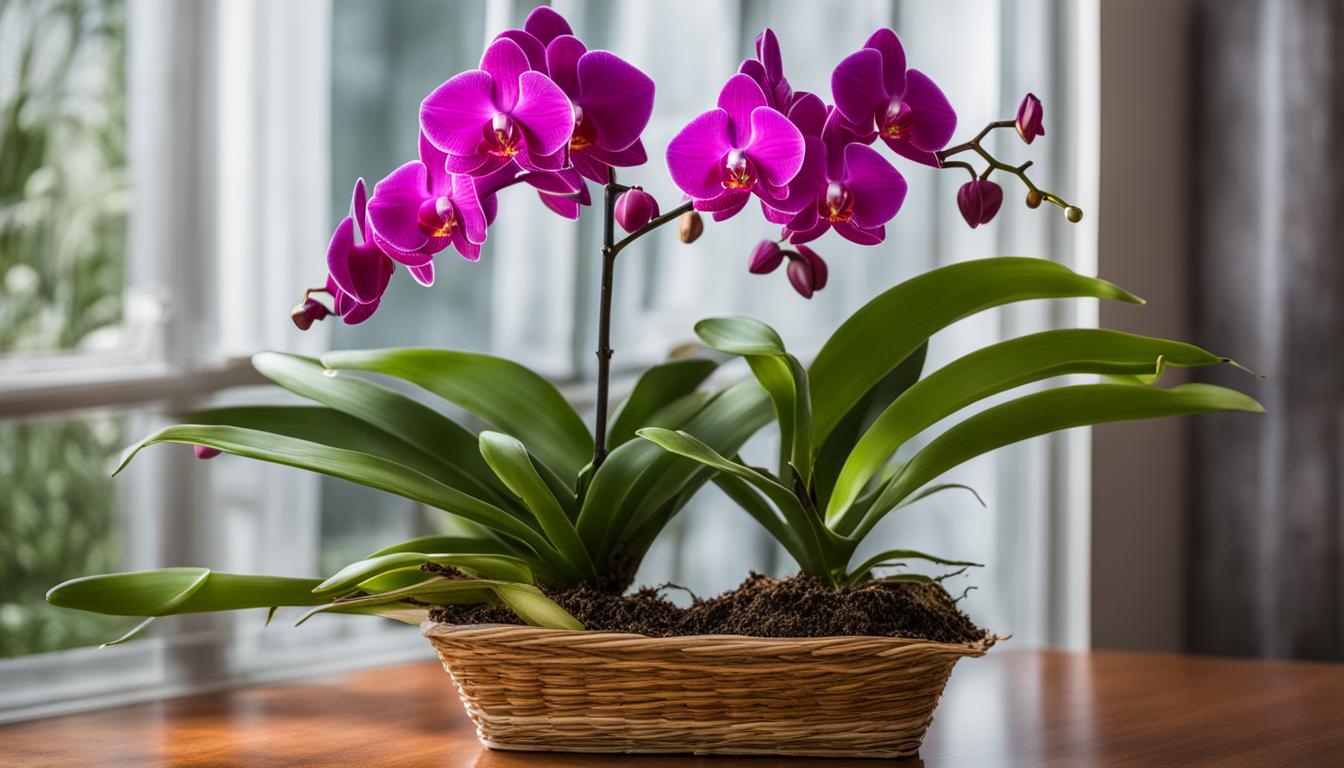As a passionate cultivator of these exotic beauties, I’ve discovered through experience that even the most sophisticated orchid growers can encounter common orchid ailments.
These challenges can range from subtle nuisances to critical threats, requiring precise orchid pest control strategies and knowledge of how to treat sick orchids effectively.
In my journey, I’ve compiled an anthology of symptoms and solutions, allowing both novice and seasoned horticulturists to excel in diagnosing orchid ailments.
Through this article, I aim to provide you with time-tested orchid care tips that I’ve gathered from experts and my own hands-on practice.
So, let’s embark on a path to ensuring the health and splendor of our cherished orchids together.
Key Takeaways
- Understand the breadth of common orchid ailments for effective prevention and treatment.
- Strategies for orchid pest control can be both proactive and reactive—knowing the difference is key.
- Learning how to treat sick orchids requires patience, accuracy, and sometimes, the courage to make tough decisions.
- Adeptness at diagnosing orchid ailments lies in keen observation and an understanding of symptoms.
- Orchid care tips aren’t only about recovery but about creating an environment where ailments struggle to take hold.
Preventing Orchid Diseases and Pest Issues
As a seasoned orchid enthusiast, I’ve learned that the key to vibrant and healthy orchids lies in preemptive measures.
Ensuring optimal orchid care requires a blend of the right environmental conditions, clean practices, and attentive monitoring.
By focusing on these preventative tactics, we can significantly reduce the risk of orchid health problems.
Optimal Environmental Conditions for Orchid Health
To fend off the threat of orchid diseases, it’s essential to provide an environment that promotes their well-being. Proper air circulation stands at the forefront of preventing bacterial growth, a common contributor to orchid ailments.
Maintaining moderate humidity levels alongside good airflow helps create unfavorable conditions for disease proliferation, underpinning successful orchid fungus treatment and overall plant health.
Sterilizing Tools and Equipment
The significance of clean cultivation practices cannot be ignored when discussing the well-being of orchids.
To sterilize tools effectively, techniques such as flame sterilization, or the application of solutions like rubbing alcohol or diluted bleach, should be employed.
This is a critical step in preventing orchid diseases, as it eliminates harmful pathogens that could otherwise spread rapidly among your collection.
Regular Health Checks for Early Detection
Diagnosing orchid ailments at the earliest stage gives your plants the best chance at recovery.
I make it a practice to thoroughly check my orchids regularly, especially when watering or during seasonal transitions.
Peering under leaves and into crevices is where early detection of orchid pests often occurs, thus averting potential widespread issues.
| Preventative Action | Benefit | Frequency |
|---|---|---|
| Ensure adequate airflow | Reduces humidity, curbing bacterial growth | Constant |
| Sterilize cultivation tools | Prevents transfer of diseases among plants | Before each use |
| Remove dead plant material | Limits insect infestations and fungal infections | As needed |
| Isolate new orchids | Protects existing plants from potential pathogens | Upon new plant arrival |
| Inspect plants closely | Allows for early intervention and treatment | At least bi-weekly |
In conclusion, integrating these orchid care tips into your routine is pivotal for preventing orchid diseases.
Sterilizing your cultivation tools, replicating optimal conditions, and carrying out regular health checks are invaluable strategies in nurturing thriving, disease-free orchids.
Embrace these practices and watch your orchids flourish.
Common Orchid Diseases and How to Treat Them
One of the challenges that orchid growers frequently face is the appearance of diseases that can potentially harm their precious plants.
Among the common orchid diseases, fungi and bacteria are often the culprits, causing everything from root rot to unsightly leaf spots.
Orchid caretakers must recognize these issues early and know how to treat sick orchids effectively to prevent further spread and damage.

When it comes to treating fungal infections, an integrated approach involving the removal of the diseased portion and the application of a suitable fungicide is generally recommended.
Bacterial infections, on the other hand, require swift action due to their rapid spread. These may be identified by a distinct odor and visible decay at the site of infection, usually accompanied by water-soaked lesions.
After removing the affected tissue, I find applying a bactericide can be an effective treatment method. Nonetheless, it is essential to isolate the sick plant to protect others from contamination.
Unfortunately, orchid virus symptoms represent a more formidable challenge due to the absence of a cure. If a virus is suspected, based on symptoms such as color breaking or streaking on the flowers, it’s best to quarantine the orchid to prevent viral transmission to healthy plants through tools or insect vectors.
- Fungal Infections:
- Identify: Root, rhizome rot, or leaf spots.
- Treat: Remove affected parts and apply fungicide.
- Prevent: Improve air circulation, and avoid overhead watering.
- Bacterial Infections:
- Identify: Foul smell and sunken, water-soaked spots.
- Treat: Cut out decayed tissue and apply bactericide.
- Viral Diseases:
- Identify: Color streaking, distorted growth.
- Manage: Isolate and maintain strict hygiene practices.
Attentive care is paramount to keep orchids thriving and healthy. By understanding the symptoms and treatments for common orchid diseases, growers can ensure their orchids continue to flourish and bring joy to their homes or gardens for many years to come.
Orchid Ailments: From Fungal Invasions to Pesky Pests
As an enthusiast in the realm of orchid care, I’ve witnessed the heartbreak of plant owners encountering the twin threats of fungal invasions and pest infestations.
Preventing these issues begins with identifying fungal infections and recognizing pest infestations, followed by a suite of orchid pest control measures, emphasizing safe pest control solutions.
Let’s delve into diagnosing and combating these ailments to ensure the longevity of our cherished orchids.
Identifying Fungal Infections and Treatment
Diagnosing orchid ailments caused by fungi is crucial – these pathogens leave distinctive marks, such as root and leaf spots, which trigger rot.
For effective orchid fungus treatment, I recommend a systematic approach. This would typically involve repotting the orchid in fresh media, meticulously cutting away the rotted roots or infected tissues, and applying a recommended fungicide.
Here’s a practical guide to handling such situations:
- Isolate the infected orchid to prevent the spread of the fungus.
- Remove all affected plant parts with sterilized tools.
- Treat with an appropriate fungicide, adhering to the usage guidelines.
- Improve care, ensuring proper watering schedule and good air circulation.
Recognizing Signs of Pest Infestations
Like detectives on nature’s trail, successfully recognizing pest infestations hinges on our regular and thorough inspections.
Aphids, mealybugs, scale, and spider mites reveal themselves through tell-tale evidence such as honeydew, webbing, or leaf discoloration.
Once identified, these pests can largely be managed with targeted treatments:
- Inspect plants diligently, especially new additions, for early signs of pests.
- Employ insecticidal soaps or miticides, following instructions for safe application.
- Reapply treatments as necessary, depending on the lifecycle of the pest.

Safe and Effective Orchid Pest Control Solutions
Ensuring our orchid pest control arsenal is both safe and effective means incorporating products like Neem oil and insecticidal soaps, which serve as my go-to remedies.
For persistent or numerous pests, such as mites, thrips, and whiteflies, consider these strategies:
| Pest | Physical Control | Chemical Control | Integrated Pest Management |
|---|---|---|---|
| Mites | Hosing or using sticky traps | Miticides | Introducing predatory insects |
| Thrips | Yellow sticky traps | Systemic insecticides | Plant companion species that deter thrips |
| Whiteflies | Vacuuming infested leaves | Insecticidal soaps | Applying reflective mulches |
Embrace safe practices by adhering to product labels, considering the impact on beneficial insects, and monitoring for resistance.
I advocate for an integrated pest management approach, combining cultural, physical, and chemical tactics to create a robust defense against ailments that could compromise our cherished orchids.
Tackling Orchid Viruses and Bacterial Problems
As an orchid enthusiast, I’ve seen first-hand the distressing signs of orchid virus symptoms, such as unexplained color streaking or a general loss of vigor within the plant.
Since these viruses have eluded available cures, our best line of defense lies in stringent preventative measures. I cannot emphasize enough the importance of strict tool sanitation to mitigate the risk of these pathogens.
This also extends to the need for tossing out or quarantining infected specimens to protect the others.

Turning to bacterial infections, the approach is somewhat different. Promptly cutting away the rotten, often foul-smelling tissue, and applying a tailored orchid bacteria treatment can save the rest of the plant.
Below, I’ve detailed the differences between symptoms of viral and bacterial infections in orchids, and the actions you can take to treat sick orchids.
| Symptom | Indicator | Treatment |
|---|---|---|
| Color Streaking | Possible Virus | Isolate and potentially discard |
| Loss of Vigor | Possible Virus | Maintain quarantine, no cure |
| Watery Lesions | Bacterial Infection | Cut out infected areas, use bactericides |
| Foul Odor | Bacterial Infection | Remove affected parts, cleanse with bactericides |
Prioritizing hygiene for your tools and providing a sanitary environment for your orchids will significantly reduce the chances of infections.
And while facing any of these issues can be discouraging, understanding how to quickly and effectively respond is the key to keeping your orchids flourishing.
Conclusion
In my journey of nurturing orchids, I’ve come to understand that the secret to maintaining orchid health is unwavering vigilance and a consistent routine of care.
Robust orchids are a sight to behold, yet they do not get there by chance. It involves providing them with their ideal growing conditions—dutiful air circulation, stable humidity levels, and routine health evaluations.
Adhering to these care practices not only celebrates the grace of these magnificent plants but also fortifies their defenses against the ravages of diseases and pests.
Maintaining Vigilance and Consistent Care for Healthy Orchids
My consistent orchid care regimen is the cornerstone of my success with these exotic plants.
From the early weeks when I chart the new growth to the long-term observation of their flowering rhythms, it has become clear that regular inspections are vital.
This is not a mere once-over; it’s delving into the cozy crevices beneath the leaves, scrutinizing the roots, and ensuring each part of the orchid is thriving.
This approach has helped me sidestep many common orchid health problems that frustrate less attentive caretakers.
When to Seek Professional Advice for Orchid Ailments
Despite our best efforts, there are moments when the complexities of orchid care can overwhelm even the most seasoned aficionados among us.
When I am confronted with a puzzling symptom or a problem stubbornly resists my best-laid treatments, I do not hesitate to seek professional advice.
This can range from the collective wisdom of orchid societies to the deep expertise of horticulturists specialized in orchids.
Navigating these challenges with expert input can turn a seemingly insurmountable orchid health obstacle into a learning opportunity, ensuring the continual splendor of these prized plants.
FAQ
How can I identify common orchid ailments?
Common orchid ailments can be identified by inspecting your orchids closely for unusual signs such as discoloration, spots, wilting, or evidence of pests. Look for aphids, scale, spider mites, and mealybugs as common pests, and watch for symptoms of fungal or viral infections like unusual growth patterns, rotting, or color streaking on leaves.
What are the best orchid pest control methods?
The best orchid pest control methods include using insecticidal soaps, Neem oil, or specific miticides to treat infestations. Be sure to follow the label instructions for application frequency and safety precautions. Additional methods include physical removal of pests, the use of sticky traps, and improving environmental conditions to discourage pest breeding.
How do you treat sick orchids?
To treat sick orchids, first, isolate the plant to prevent the spread of disease. Remove the affected tissue, apply appropriate fungicides for fungal infections, and use bactericides for bacterial infections. Follow up with improved care for your orchid, adjusting watering, light, and temperature conditions as needed.
What are optimal environmental conditions for orchid health?
Optimal environmental conditions for orchid health include adequate air circulation, humidity control, and the right amount of light. Orchids also require specific temperature ranges and regular, appropriate watering. Each variety may have unique needs that need to be met to maintain its health.
Why and how should I sterilize my orchid tools and equipment?
Sterilizing orchid tools and equipment is crucial to prevent the spread of disease among your plants. Tools can be sterilized by flaming, soaking in a bleach solution, or using rubbing alcohol. It’s essential to perform sterilization before and after working with each plant, especially when cutting or managing infected tissue.
How can regular health checks aid in the early detection of orchid pests?
Regular health checks enable you to spot the early signs of pest infestation, which is key to managing and controlling the situation before it becomes widespread. Checking your orchids during watering, when new growth appears, or as seasons change will allow you to act quickly against pests.
How are common orchid diseases treated?
Common orchid diseases such as fungal and bacterial infections are treated by removing the affected parts of the plant and applying a fungicide or bactericide where appropriate. Ensure proper plant care practices are followed to prevent future occurrences.
How do I identify fungal infections and provide treatment for my orchids?
Fungal infections often present as root rot, leaf spots, and blighting of petals. To treat fungal infections, remove the infected areas of the orchid, treat with a recommended fungicide, and repot the plant in fresh media. Improving air circulation and light exposure can also help prevent future fungal issues.
What are the signs of pest infestations in orchids?
Signs of pest infestations in orchids include the presence of small bugs on the underside of leaves, sticky honeydew residue, webbing, and visible damage to leaves or flowers. Regular checks and maintenance are needed to spot and manage pest problems early on.
What orchid pest control solutions are safe and effective?
Safe and effective orchid pest control solutions include the use of insecticidal soaps, horticultural oils like Neem oil, and targeted chemical controls like miticides, if necessary. Always use these products according to the manufacturer’s instructions and consider the orchid species’ sensitivity to chemicals.
What should I do if my orchid shows virus symptoms?
If your orchid shows virus symptoms, such as color streaking or a decline in health, unfortunately, there is no cure. It is best to isolate the affected plant to prevent the spread to others and maintain strict sanitary practices. Remove and destroy the infected plant to protect your collection.
How can I treat bacterial problems in my orchids?
Treat bacterial problems in orchids by carefully cutting away the affected tissue, avoiding spreading the bacteria. After removing the infected parts, apply a bactericide according to the label’s directions, and take steps to improve air circulation to prevent further infection.
How can maintaining vigilance and consistent care prevent orchid diseases?
Maintaining vigilance and providing consistent care for your orchids help prevent diseases and pest infestations by ensuring that the plants remain as healthy and resilient as possible. A robust orchid is better able to withstand stressors and less likely to succumb to ailments.
When should I seek professional advice for orchid ailments?
You should seek professional advice if you are unable to diagnose the problem, if your orchids continue to decline despite your best efforts, or when dealing with persistent or elusive symptoms that do not respond to standard treatments. Orchid societies, horticulturalists, and plant pathologists can provide specialized assistance.


Leave a Reply